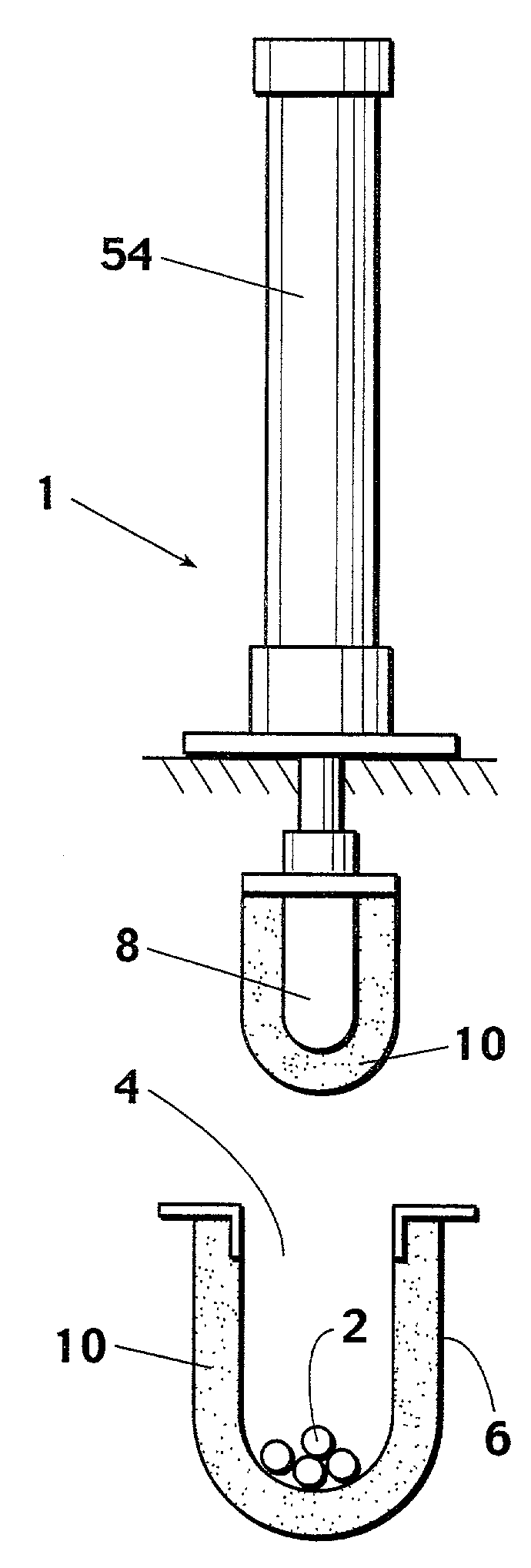Liquid infusion and tenderization process, apparatus, and product
a liquid infusion and tenderization technology, applied in the field of liquid infusion and tenderization process, apparatus, and product, can solve the problems of affecting reducing the quality of the product, so as to reduce the need for purchase, installation, operation and maintenance. the effect of muscle protein or overall structur
- Summary
- Abstract
- Description
- Claims
- Application Information
AI Technical Summary
Benefits of technology
Problems solved by technology
Method used
Image
Examples
embodiment 1
[0046]An embodiment 1 of an inventive apparatus for use in the first stage operation of the inventive method is depicted in FIGS. 1-3. Using inventive apparatus 1, the product, either food or meat 2, is brought into a compression area 4 (see FIGS. 1 and 2). This area preferably comprises two hard surfaces 6 and 8 that are covered with a thick pliable material 10. This material is selected to conform to the shape of the product 2, especially in the case of a non-homogeneous material such as a bone-in meat cut. These two surfaces preferably comprise a fixed surface 6 and a closing, movable surface 8. There is of course a force behind the movable surface such as a screw actuator, pneumatic or hydraulic cylinder, or other such mechanical device 54.
[0047]The fixed surface 6 will preferably be of a captive-type geometry, such as a “U” or “V” shaped trough, to control movement of the product. The moving surface 8 (e.g., a plunger as shown in FIGS. 1-3) will preferably have a corresponding ...
embodiment 50
[0053]To provide continuous operation and throughput, the inventive pressing apparatus preferably comprises a plurality of pressing chambers 4 arranged in a linear or rotary fashion. An embodiment 50 of the inventive continuous apparatus is depicted in FIG. 3. Inventive apparatus 50 comprises a plurality of U-shaped pressing chambers 4 provided in a rotary bucket wheel 52. Apparatus 50 also includes a plurality of plungers 8 reciprocatingly positioned above bucket wheel 52. Plungers 8 employ mechanisms 54 for varying the pressure of the plungers 8 into cavities 4. As will be apparent to those skilled in the art, examples of suitable pressure mechanisms 54 include pneumatic or hydraulic cylinders having appropriate pressure regulators or mechanical pressing systems with associated force indicators and controls.
[0054]The inventive pressing apparatus preferably also includes: an infeed conveyor 56; a chute 58 with a flexible end piece 60 for delivering product 2 into rotating cavities ...
embodiment 150
[0061]An alternative embodiment 150 of the inventive pressing apparatus is depicted in FIGS. 8 and 9. Inventive pressing apparatus 150 is a double conveyor device which preferably comprises: a frame or other support structure 152; a lower continuous belt 154 rotatably mounted in frame 152; an upper continuous belt 156 rotatably mounted in frame 152 above lower belt 154; at least one pressing roller (preferably at least two) 158 adjustably positionable beneath and against the upper carrying run 160 of lower belt 154; at least one upper pressing roller (preferably at least two) 162 adjustably positionable above and against the lower pressing run 164 of upper belt 156; and vertical containment walls 166 positioned on each side of belts 154 and 156 for retaining product carried through inventive apparatus 150. As will be understood by those skilled in the art, inventive apparatus 150 will also include motors, belts, chains, sprockets and / or pulleys for directly or indirectly driving bel...
PUM
 Login to View More
Login to View More Abstract
Description
Claims
Application Information
 Login to View More
Login to View More - R&D
- Intellectual Property
- Life Sciences
- Materials
- Tech Scout
- Unparalleled Data Quality
- Higher Quality Content
- 60% Fewer Hallucinations
Browse by: Latest US Patents, China's latest patents, Technical Efficacy Thesaurus, Application Domain, Technology Topic, Popular Technical Reports.
© 2025 PatSnap. All rights reserved.Legal|Privacy policy|Modern Slavery Act Transparency Statement|Sitemap|About US| Contact US: help@patsnap.com



